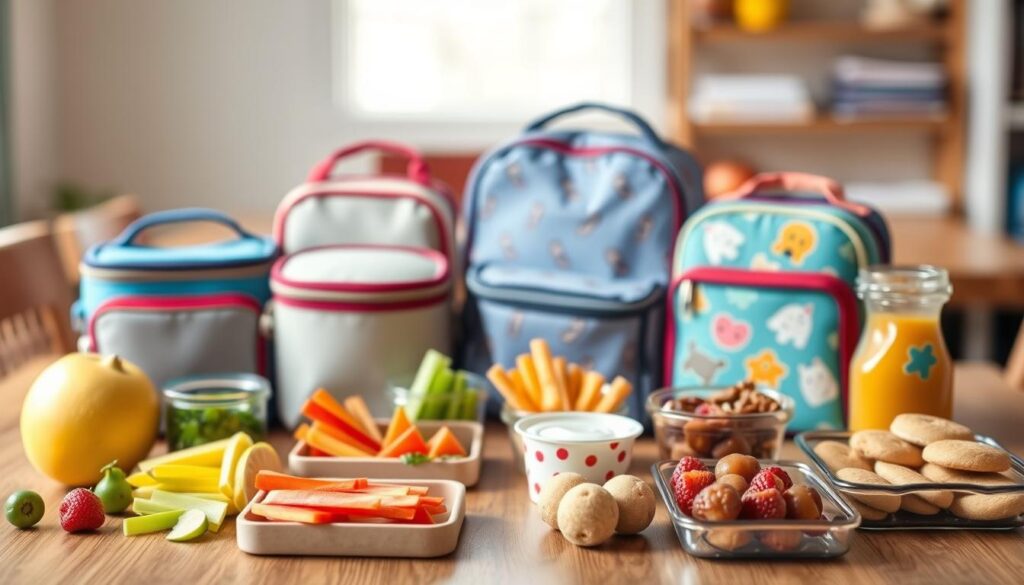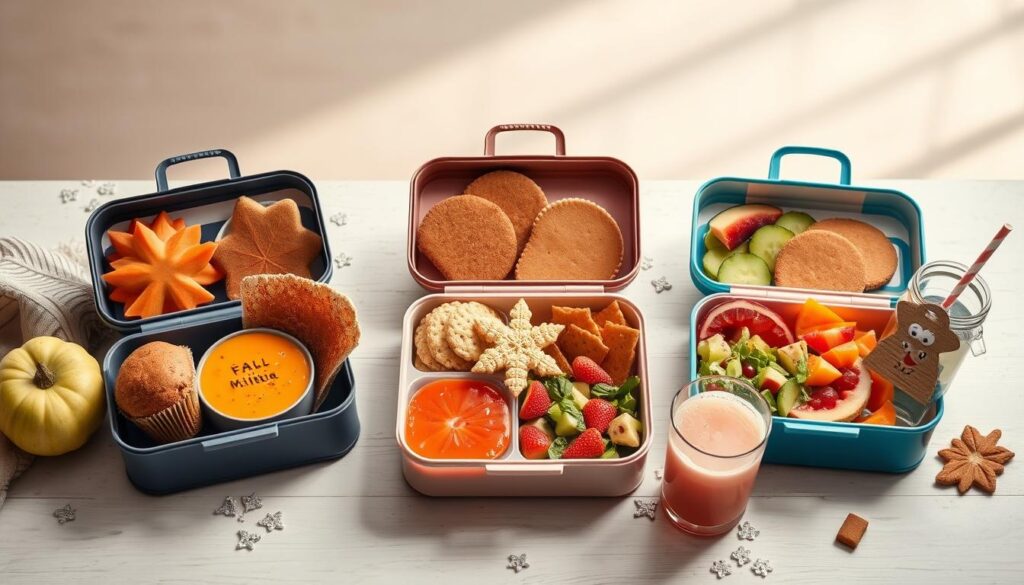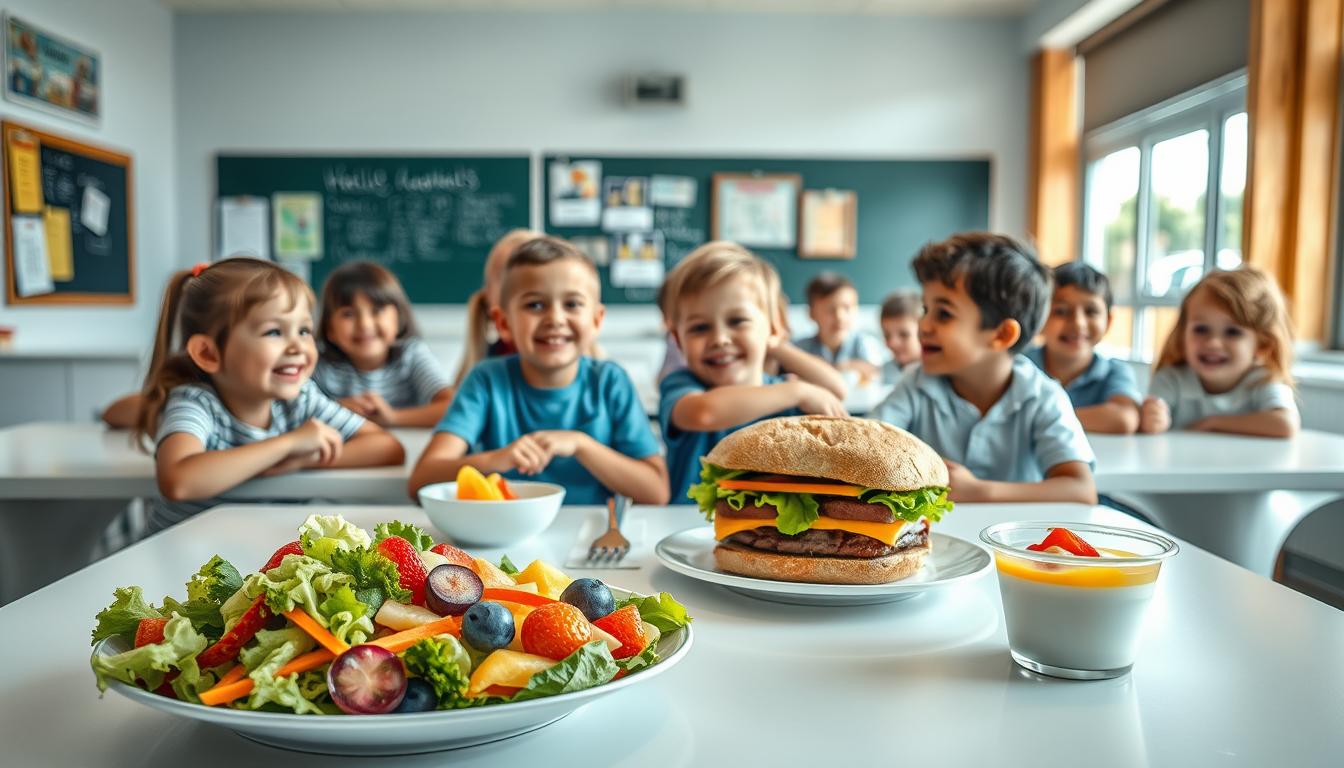Table of Contents
It’s crucial to know your child starts each school day with a nutritious meal. Busy mornings and picky eaters make finding healthy lunch ideas for kids a challenge. But what if you could serve meals that are both healthy and delicious?
This guide offers kids school lunch ideas that fit into your busy life. No complicated recipes here. Just smart strategies to make lunch prep easy for you and your family.
Key Takeaways
- Discover 10+ healthy lunch ideas for kids that take 10 minutes or less to assemble.
- Learn how to balance nutrition with kid-approved flavors and textures.
- Get tips to reduce waste and save time with smart meal prep strategies.
- Find solutions for common challenges like allergies, picky eaters, and budget limits.
- Explore creative presentation tricks to make lunchtime something your child looks forward to.
Why Nutritious School Lunches Matter for Your Child’s Development
Nutritious lunches are more than food—they fuel growth and learning. Every meal you pack affects their focus, energy, and health choices. Here’s why it matters:
The Connection Between Nutrition and Classroom Performance
Meals rich in protein, whole grains, and veggies give kids steady energy. Studies show balanced meals boost attention and test scores. A turkey wrap with veggies keeps brains sharp during math class.
Sugary snacks, on the other hand, cause energy crashes midday.
Establishing Healthy Eating Habits Early
Kids who eat colorful veggies or whole-grain sandwiches learn to prefer nutritious foods. These habits lower obesity and disease risks later in life. Small choices now build lifelong patterns.
Common Nutritional Pitfalls in Typical School Lunches
- High-sugar snacks like candy or soda.
- Processed meals packed with sodium and artificial additives.
- White bread and sugary cereals bars that spike then crash energy.
These choices leave kids tired or unfocused. Opt for fresh foods to avoid these traps.
Quick and Easy Kids School Lunch Ideas for Busy Mornings
Save time without losing nutrition with these easy school lunch recipes and kids school lunch ideas. They’re perfect for busy mornings, ready in 10 minutes or less. Here are three top picks:
| Recipe | Ingredients | Prep Time |
|---|---|---|
| Veggie Roll-Ups | Whole wheat tortillas, hummus, shredded carrots, turkey slices | 5 minutes |
| Yogurt Parfait Packs | Plain Greek yogurt, granola, frozen berries | 3 minutes |
| Baked Chicken Nuggets | Chicken tenders, breadcrumbs, egg wash | 7 minutes (baking done the night before) |
Pair these with pre-cut veggies or fruit cups for a balanced meal. Here’s how to streamline your routine:
- Prep proteins like baked nuggets on Sunday nights
- Use compartmentalized containers for no-assembly-needed meals
- Let kids choose one item from each category to encourage participation
These easy school lunch recipes stay fresh and tasty with proper packing. Mix and match to keep lunches exciting without extra effort.
Building a Balanced Lunchbox: The Essential Nutrition Components
Every well-planned lunch starts with a balance of key nutrients. To create healthy lunch ideas for kids that boost focus and energy, ensure each meal has protein, whole grains, produce, and healthy fats. These elements form the foundation of nutritious lunches for students that keep them fueled until the final bell.
Protein Power: The Foundation of Growing Bodies
Protein keeps muscles strong and hunger at bay. Add turkey slices, hard-boiled eggs, or chickpeas to every lunchbox. For plant-based options, try edamame or Greek yogurt.
- Grilled chicken strips
- Beef jerky (low-sodium)
- Hummus with veggie dippers
Whole Grains and Complex Carbohydrates for Sustained Energy
Swap white bread for whole grain wraps, brown rice, or quinoa. These options provide slow-releasing energy to avoid midday crashes.
- Whole grain tortillas
- Rye crackers
- Oatmeal muffins with berries
Fruits and Vegetables: Aiming for Color and Variety
Include at least two colorful produce options daily. Sliced apples, baby carrots, or snap peas add vitamins without prep stress.
- Apple slices with cinnamon
- Mini bell pepper boats stuffed with tuna
- Trail mix with dried fruit and nuts (if allowed)
Healthy Fats for Brain Development
Avocado, almond butter, or chia seeds provide fats critical for cognitive function. Sprinkle over salads or spread on toast.
- Guacamole with whole grain pita chips
- Almond butter packets
- Seaweed snacks (low-salt)
Age-Appropriate Lunch Options: From Kindergarten to High School

Every child’s lunch needs change as they grow. Here’s how to tailor lunchbox ideas for children to their age:
| Age Group | Key Needs | Top Options |
|---|---|---|
| Kindergarten | Easy to eat, no mess | Cheese cubes, apple slices, mini muffins |
| Upper Elementary | Flavor variety, social acceptance | Whole-grain wraps, veggie sushi rolls, trail mix |
| Middle School | Peer appeal, independence | Pre-cut veggies with guacamole, grab-and-go energy bars |
| High School | Energy for activities, time efficiency | Whole grain pasta salads, turkey-and-cheese rolls, hard-boiled eggs |
For packable lunches for kids, think about their daily routine. Young kids need small pieces to avoid spills. Teens might like ready-to-eat items like pre-marinated grilled chicken strips. Always check school policies on nut-free or allergen restrictions.
Adjust portion sizes as they grow. Kindergarteners do well with ¼ sandwich servings. Teens might need double servings of proteins.
Let your child help pick from approved options. This makes them more excited about their lunch. Use containers for younger kids and single-serving packs for teens. Make sure they can open them easily until they learn to do it themselves.
Making Lunches Fun: Creative Presentation Ideas That Entice Picky Eaters
Turning school lunches into fun doesn’t take extra time. It just needs smart presentation. Even healthy meals can look less appealing if they’re not inviting. Here’s how to make lunches that excite kids without losing nutrition.
Bento Box Basics for Visually Appealing Meals
Bento boxes help separate foods kids might not like together. Try making carrot sticks into a rainbow or hummus into a smiley face. Layer berries for a colorful mosaic. Balance is key: protein, veggies, and a treat.
Most kids love the small portions and the variety. It makes lunchtime fun.
Food Art That Doesn’t Require Artistic Skills
Make broccoli into tiny trees with pretzel sticks. Create animal faces on toast with avocado and radish. Use ketchup dots for wraps or licorice for “hair.” These ideas take just 2 minutes but make meals unforgettable.
Try themed days like “Outer Space” lunches with star-shaped cheese and blueberry planets. It adds excitement to the meal.
Using Cookie Cutters to Transform Ordinary Foods
- Press star-shaped cutters into sandwiches for galaxy-themed lunches.
- Cut cucumbers and apples into flower petals for garden-inspired meals.
- Shape turkey slices into dinosaurs or cars with toothpicks and cheese wheels.
Kids often eat with their eyes first. These creative school lunch options use tools you already have. They turn everyday foods into adventures, no cooking skills needed.
Weekly Meal Prep Strategies to Save Time and Reduce Morning Stress
Learning school lunch planning tips means creating systems for calm. These weekly plans help you save time and make sure lunches are healthy and tasty.
Weekend Prep Routines Made Simple
Take 30 minutes each weekend for prep. Chop veggies, grill proteins, and pack snacks. Here’s a simple checklist:
- Wash and slice carrots, bell peppers, and apples
- Cook a batch of whole-grain wraps or turkey meatballs
- Divide snacks into single-serving bags
Freeze What You Can for Last-Minute Savings
Freeze items like muffins, quinoa, or turkey slices. Label them with dates for later use. Pack frozen berries to keep them fresh.
Rotate Your Menu with a Monthly Plan
Plan meals for 2 or 4 weeks using a calendar. Choose themes like “Taco Tuesday.” Rotate proteins and veggies to keep things interesting. Use apps like Mealime or Yummly for help.
These tips make meal prep easy. Weekend prep, smart freezing, and a rotation plan reduce stress. You’ll have healthy lunches all year.
Navigating Dietary Restrictions: Allergy-Friendly and Special Diet Lunch Ideas
When packing lunchbox ideas for children with dietary restrictions, creativity and preparation are key. Start by identifying allergens like nuts, dairy, or gluten, then swap ingredients with safe options. For example, use sunflower seed butter instead of peanut butter or gluten-free wraps for sandwiches. Many brands like Enjoy Life Foods offer allergy-friendly snacks that fit healthy lunch ideas for kids.
Vegetarian or vegan lunches can include hummus with veggie sticks, quinoa salads, or black bean tacos. Paleo diets might focus on roasted turkey rolls with cucumber and avocado. Always check labels for hidden ingredients—watch for soy in sauces or dairy in protein bars. Resources like Food Allergy Research & Education (FARE) provide guides to decode labels.
- Gluten-free options: Explore brands like Glutino for bread or Bob’s Red Mill for pasta.
- For egg allergies: Try chia seed “eggs” in recipes or opt for lentil-based proteins.
- Low-sugar lunches: Pack fresh fruit instead of dried fruits and use unsweetened nut milks.
Communicate with schools about your child’s needs. Provide written plans outlining restrictions and safe snacks. Encourage kids to help choose their lunchbox ideas for children to foster independence. With these strategies, even restricted diets can stay tasty, safe, and nutritionally balanced.
Seasonal Inspiration: Tailoring Your Child’s Lunches Throughout the School Year
Changing up school lunches with seasonal ingredients keeps meals exciting and nutritious. Let’s explore how to align creative school lunch options with the changing seasons. This way, every season brings something new to the lunchbox.

Embrace autumn’s bounty with roasted sweet potato wedges, pumpkin hummus, or cinnamon-spiced apple slices. Pack delicious school snacks like trail mix with dried cranberries or mini muffins made with oat flour and zucchini. Use cookie cutters to shape turkey-and-cheese sandwiches into leaf shapes.
Winter Comfort Foods That Travel Well
Fill insulated containers with hearty soups—try carrot-ginger or lentil—paired with whole-grain rolls. Include portable winter fruits like Clementines or dried apricots. Thermos-ready meals like chili or vegetable stew keep kids warm on chilly days.
Spring and Summer Fresh Produce Options
Transition to crisp salads with strawberries, cucumber slices, or chilled soba noodles. Use ice packs to keep berries, watermelon cubes, or yogurt-based dips fresh. Grilled veggie wraps or chilled soba noodles make light yet filling creative school lunch options.
Budget-Friendly Lunch Solutions That Don’t Sacrifice Nutrition
It’s possible to make packable lunches for kids without spending a lot. By using smart strategies, you can turn simple ingredients into easy school lunch recipes. Start with affordable proteins like canned beans or chicken packs. These pair well with whole grains and fresh veggies.
Strategic shopping tips:
- Buy bulk grains (quinoa, oats) and divide into meal-sized portions
- Choose frozen veggies for year-round availability at lower prices
- Clip coupons for store-brand reusable containers
Turn last night’s dinner into a new lunch:
| Dinner Leftover | Lunch Transformation |
|---|---|
| Roasted chicken | Shredded into taco bowls with corn tortillas |
| Vegetarian chili | Cooled and layered into stuffed sweet potatoes |
| Pasta primavera | Mixed with mozzarella balls for “caprese pasta salad” |
Make your own to save money:
| Store-Bought Item | Homemade Version | Cost Savings |
|---|---|---|
| Individual yogurt cups | Large tub yogurt + fruit topper | $0.50 per serving vs. $1.25 |
| Packaged trail mix | Nuts + dried fruit + pretzels mix | $0.75 per serving vs. $1.50 |
Batch-cooking on weekends saves time and money. Use airtight containers to keep food fresh and avoid single-use packaging. Small changes can lead to big savings over time.
Getting Kids Involved: How to Encourage Participation in Lunch Planning and Preparation
Getting your child involved in lunch prep makes mealtime fun. When they pick delicious school snacks or make fun lunch ideas for school, they’re more likely to eat it. Start with simple tasks: let toddlers wash veggies and teens measure ingredients. Here’s how to get them involved:
- Choice with limits: Give them 2-3 options for proteins, grains, or veggies. “Pick your sandwich filling: turkey, hummus, or cheese?”
- Age-based tasks: Preschoolers can spread peanut butter; older kids can chop soft fruits with supervision.
- Taste-testing Tuesdays: Try new recipes together. Rate favorites on a 1-5 scale to decide next week’s menu.
Ages 6-8: Help pack their lunchbox, choosing from parent-approved options
Ages 9-12: Design weekly themes (e.g., “Taco Tuesday” with fillings to assemble
Teens: Let them plan a day’s meals, using leftovers creatively
| Age Group | Tasks | Examples |
|---|---|---|
| 3-5 | Washing produce, arranging snacks | Sorting apple slices into containers |
| 6-8 | Measuring ingredients, using kid-safe tools | Spreading cream cheese on bagels |
| 9-12+ | Reading recipes, using appliances safely | Making veggie wraps with a microwave-safe plate |
Stay positive and praise their creativity. Let them sticker a “My Lunch Creation” chart. This builds independence and nutrition literacy. Remember, small steps today lead to healthy habits tomorrow.
The Right Tools for Success: Lunchboxes, Containers and Gear That Keep Food Fresh and Appealing
Packable lunches for kids need the right containers to stay fresh and appealing. The right gear keeps meals safe and tasty until lunchtime. Start by picking containers for both hot and cold items.
Insulated thermoses, like Yeti’s food jars, keep soups warm for hours. Stainless steel containers with silicone seals keep cold items cool.
Eco-friendly materials make school lunch planning easier and reduce waste. Use beeswax wraps or reusable silicone lids instead of plastic wraps. Stasher offers airtight bags that are durable.
Stainless steel tiffins are great for stacking and last for years. They help reduce single-use plastics. Look for BPA-free options that are safe for microwave and dishwasher use.
Age is important when choosing containers. Preschoolers need spill-proof cups with bite-proof lids, like LunchBots 3-in-1 boxes. Older kids might prefer containers they can open quickly.
Check for leak-proof zippers and wide compartments for snacks. Teach kids to spot their gear with colorful stickers or engraved initials.
- Invest in durable containers with tight seals to prevent leaks
- Opt for lightweight gear that fits easily in backpacks
- Choose containers that can go from fridge to microwave without cracking
Keep tools in good condition to make them last longer. Wash containers daily with hot soapy water. Let silicone lids air dry upside down.
Store extras in a bin near your pantry for quick mornings. Look for brands with warranties for long-term value.
Smart gear choices make school lunch planning easy. Choose containers that keep food safe, protect the planet, and fit your child’s growing independence. These tools make packing lunches a breeze, so your kids enjoy meals that fuel their day.
Conclusion: Creating School Lunch Routines That Work for Your Family
Every family is unique when it comes to school lunches. The key is finding a balance between healthy food and ease. Start with small changes, like trying a new recipe or a different way to pack lunches.
Letting your child choose a favorite fruit or help with lunch can make meal prep fun. It turns a chore into a shared activity.
If lunches come back untouched or you’re short on time, go back to the tips in this guide. Swap out foods your child doesn’t like for new ones. For example, if they don’t like sandwiches, try veggie sticks with hummus or whole-grain wraps.
Nutritious lunches don’t have to be perfect every day. Focus on consistent patterns, not every meal being perfect.
Spending time on these meals does more than just give energy for the day. It builds lifelong habits with food. Small changes, like using insulated containers or prep on weekends, help you succeed.
Remember, it’s about making progress, not being perfect. You’re working towards a routine that nourishes both body and mind.
FAQ
What are some easy school lunch recipes that kids will actually eat?
Easy school lunch recipes include turkey and cheese roll-ups. You can also make homemade mini pizzas using whole grain pita. Veggie-packed quesadillas are another great option.
Try pasta salad with colorful vegetables or yogurt parfaits with fruit and granola. The key is to mix nutritious ingredients with fun presentation!
How can I ensure my child’s school lunch is both healthy and appealing?
To make lunches healthy and appealing, use colorful fruits and vegetables. Include whole grains and protein-rich options. Let your child help pick foods they like.
Use fun presentations like bento boxes or sandwich-shaped cookie cutters. This makes meals more attractive.
What are some fun lunch ideas for school that won’t take much time to prepare?
Fun lunch ideas include DIY lunchables with whole grain crackers, cheese, and turkey. Try colorful fruit skewers or wrap sandwiches cut into pinwheels.
Adding a small treat, like trail mix or homemade granola bars, makes lunch exciting!
How can I prepare budget-friendly lunches without sacrificing nutrition?
For budget-friendly lunches, shop for seasonal produce and buy in bulk. Repurpose dinner leftovers creatively. Make simple homemade snacks, like energy balls or yogurt cups, to avoid expensive pre-packaged items.
What are some packable lunches for kids with dietary restrictions?
For kids with dietary restrictions, try nut-free energy bars or gluten-free wraps with turkey and veggies. Dairy-free fruit smoothies are also good. Always check food labels and get creative with alternatives.
Consulting with your child helps make meals appealing while meeting their dietary needs.
Are there any school lunch planning tips to make mornings less stressful?
Plan ahead by prepping ingredients over the weekend. Use a checklist for lunch components. Create a rotation system to avoid monotony.
Involving your kids in the process streamlines the morning. Setting a designated lunch-packing station saves time.
How can I get my kids involved in lunch planning and preparation?
Encourage your kids to participate by giving them choices from a parent-approved list. Ask for their input on weekly menu plans. Let them help pack their lunch.
Organize fun family taste tests to discover new items they’d like in their lunch.
What are some nutritious school snacks I can include in my child’s lunchbox?
Nutritious snacks include sliced fruit with nut butter, whole grain crackers with cheese, and veggie sticks with hummus. Energy bites made from oats and dried fruit are also good.
Aim for a mix of protein, healthy fats, and fiber to keep them satisfied and energized!
How can presentation make a difference in encouraging my child to eat their lunch?
Fun and engaging presentations make nutritious lunches more appealing. Use bento boxes, character-themed food art, or colorful arrangements of food.
Making the meal visually exciting boosts your child’s willingness to eat.
What are some creative school lunch options to keep my child interested throughout the school year?
Get creative with lunches by experimenting with international flavors, like sushi rolls or taco wraps. Use seasonal ingredients and different types of bread.
Consider themed lunches based on holidays or special events. This keeps offerings varied and exciting!

